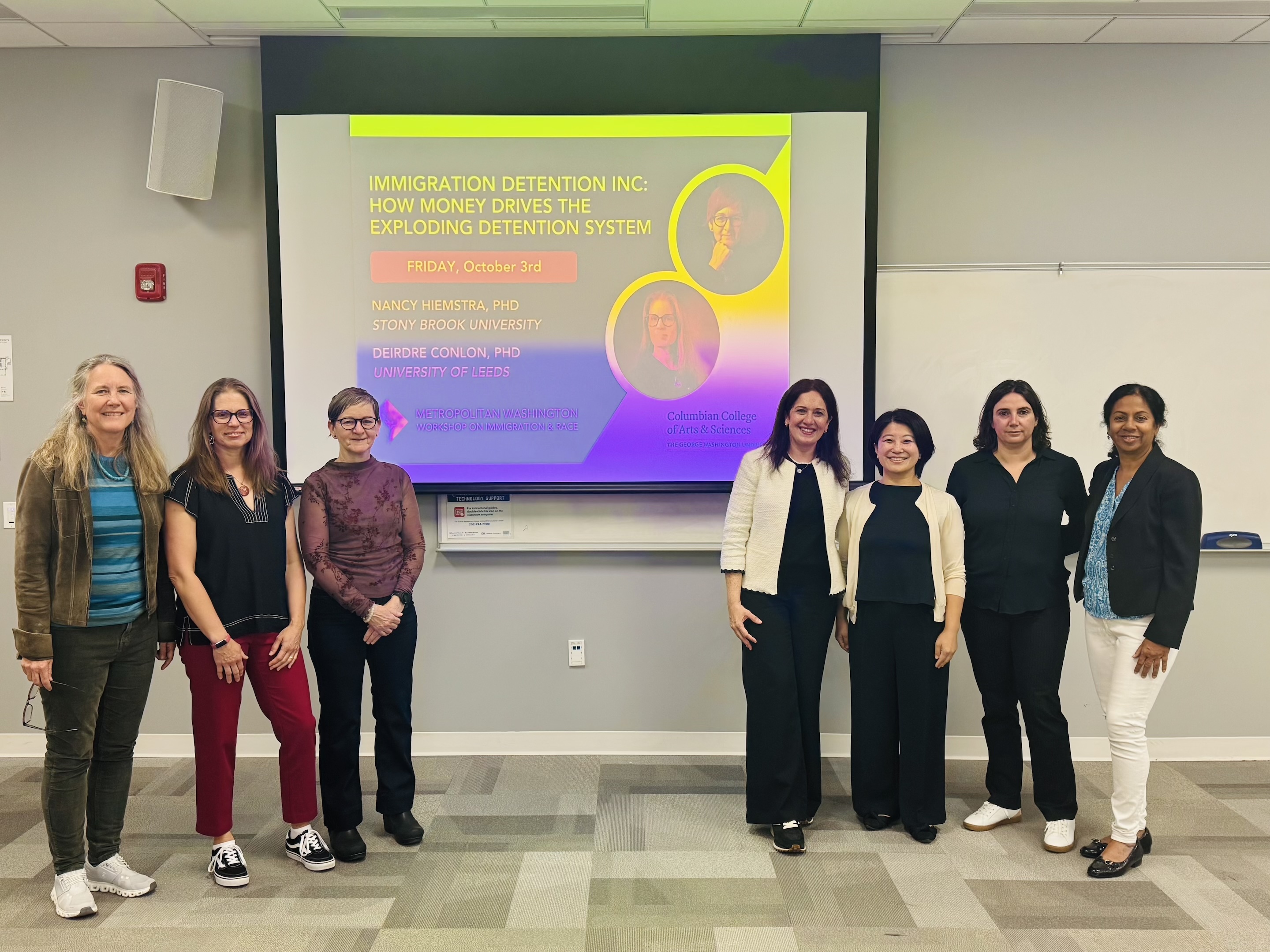By Rick Tzompa-Chimal
On Friday, October 3, Dr. Nancy Hiemstra from Stony Brook University and Dr. Deirdre Conlon from the University of Leeds led a discussion at the Metropolitan Washington Workshop on Immigration & Race (MWWI&R) on their new book, Immigration Detention Inc: The Big Business of Locking Up Migrants. The discussion entitled, “Immigration Detention Inc: How money drives the exploding detention system,” focused on the internal economies of profits made through immigration detention while detainees suffer from mistreatment in U.S. facilities.
A joint effort by The George Washington University and Georgetown University, the event examined the numerous ways in which immigration detention generates significant profits, while detainees are starved, sickened, and exploited as a matter of routine operation.
Drawing on over a decade of research on detention centers in New Jersey and New York, Dr. Hiemstra and Dr. Conlon provide critical historical and contemporary context for understanding the surging detention numbers under the second Trump administration. According to scholar and former MWWI&R presenter Austin Kocher, the total number of people detained as of August 24, 2025, hit a new record high of 61,226.

As Dr. Hiemstra highlighted, the United States did not have an expansive immigration detention system until recently, “there has been a major expansion since the mid-1900s of 5,000 detainees nationwide to roughly 60,000 detainees on any given day nationwide, which makes the U.S. the largest detention system in the world.” Dr. Conlon shared that: “the revenue from detention of the two largest groups in the detention system, CoreCivic and GEO Group, accounts for 44% and 30% of their revenue in 2022, respectively.”
Food is at the center of the cost-cutting efforts, says Dr. Heimstra, “Starving and sickening the people in detention is how these places become profitable.” The food being served can cause sickness from being spoiled, having food-born illness and bugs, and unhygienic practices. She adds that, “bad food is the business model because the less you spend on food, the more money you can make.” She explained that subcontractors are given the responsibility to provide these facilities with food, medical care, and commissary services. This means subcontractors are selling their services to prisons and jails, making the priority lower prices rather than higher quality goods, meals, and care for detainees.
Dr. Conlon shares that in their research found that “commissary items tend to sell for 4 to 7 times retail price” from a typical Walmart store. These higher prices pressure detainees to join the voluntary labor program found in all the facilities studied. These are “voluntary in name only,” Dr. Conlon states, working in areas that keep the facility going like working as kitchen staff, barbers, library staff and they can cut costs by employing their work for very low pay.” In the study sites, those participating in the program are paid about $1 for a standard 8-hour workday.
The extremely low pay pushes detainees to remain in the work program, which in turn lowers staff costs for the detention centers. The facilities also generate a profit from the highly priced commissary goods, which often are better than the food provided. This is one example of how detention centers exhibit their internal economies. This cycle raises profits while maintaining costs as low as possible, which ultimately impacts the health and well-being of people who are detained.
Dr. Hiemstra also emphasizes the lack of, and poor quality of medical care provided in these facilities. She shares that “care is delayed or denied, there are poorly trained and staffed offices, inappropriate treatment of women’s health issues, and barriers to receiving care through language barriers and discrimination.” The reason being, “cost containment is the goal,” Dr. Hiemstra states. There has been “an alarming death rate that is preventable by providing care, preceding this administration but rising since January 2025.”
Dr. Conlon concluded the discussion with some ways to raise awareness about the mistreatment of detainees in the U.S. detention system. She notes that having a robust community of supporters, rapid response networks, and accompaniments are very helpful. As she noted, “Attention should be directed to the money made in detention… and the solution to break the web of dependency, is to price out detention, and make it less profitable.” To improve conditions for those detained, she suggested there’s an opportunity to “not make it more palatable, but ensure fair wages in jails, not giving the contract to the lowest bidder always.”
What has worked, she says, are “boycotts and divestment campaigns, like the successful divestment of the New York State Pension Fund from CoreCivic and GEO Group.” She also suggests that legal challenges are worthwhile, as they stop and slow the profiteering of the detention centers. Moving forward, she argues that we can change the prevailing narrative and normalization of detention for immigration enforcement. Dr. Conlon and Dr. Hiemstra remind us that the U.S. detention system has not always been such a big business, with a more limited system as recently as the mid-1990s, and that returning to a system that prioritizes people over profit is possible.
The Metropolitan Washington Workshop on Immigration and Race is organized by the Cisneros Institute, the Department of Geography & Environment, the Department of Sociology, and the Center for Immigration and Migration Studies at The George Washington University, as well as by the Georgetown University Institute for the Study of International Migration.


